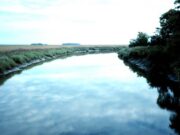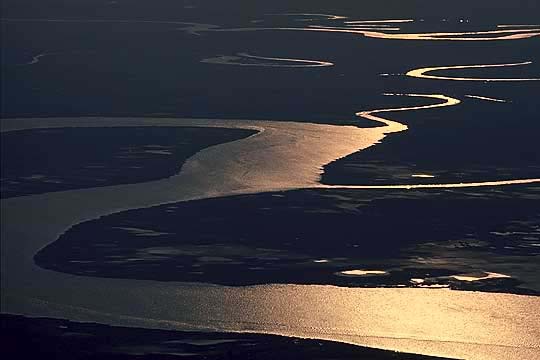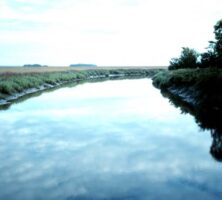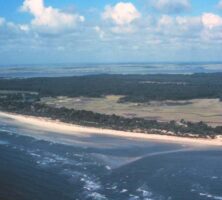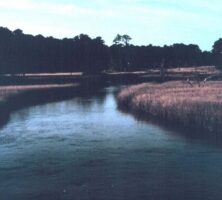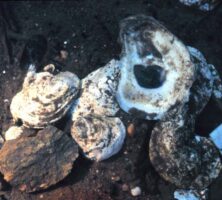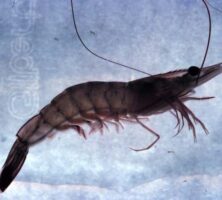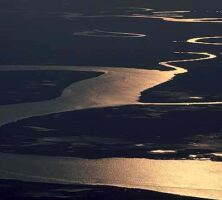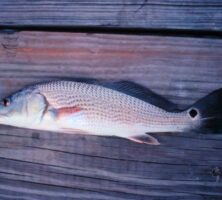Estuaries, where freshwater mixes with saltwater, are dominant and vital ecosystems along Georgia’s coast. They are transition zones between river and sea and provide critical habitat for an assortment of plants and animals. More than 70 percent of Georgia’s recreationally and commercially important fishes, crustaceans, and shellfish spend at least part of their lives in estuaries.
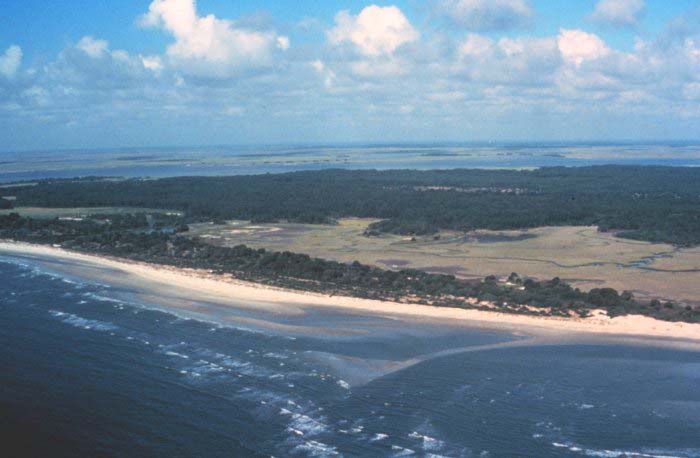
Courtesy of Sapelo Island National Estuarine Research Reserve and National Oceanic and Atmospheric Administration/Department of Commerce
In general, an estuary is a semi-enclosed body of water with a free connection to the ocean. There, saltwater from the ocean is measurably diluted with freshwater from a river or stream. Freshwater also may come from local storm runoff and groundwater.
The major estuaries of Georgia generally connect with the Atlantic Ocean through large bodies of water called sounds, which lie between coastal barrier islands and separate them. From north to south on Georgia’s coast, they include Wassaw Sound, Ossabaw Sound, St. Catherines Sound, Sapelo Sound, Doboy Sound, Altamaha Sound, St. Simons Sound, St. Andrews Sound, and Cumberland Sound.
Saltwater in the sounds is diluted by freshwater from five major Georgia rivers that originate inland and flow to the coast: the Altamaha, Ogeechee, Satilla, Savannah, and St. Marys rivers. The Altamaha, for example, contributes freshwater to Altamaha Sound; the Ogeechee to Ossabaw Sound; the Satilla to St. Andrew Sound; and the St. Marys to Cumberland Sound. Some estuaries, however, may have little or no input from major freshwater streams. No large freshwater river, for instance, enters Wassaw Sound near the city of Savannah. Its freshwater sources include direct rainfall, local drainage, and groundwater.
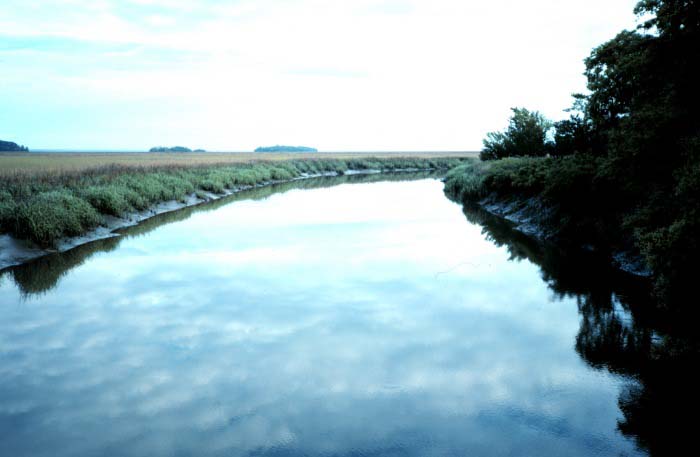
Courtesy of National Oceanic and Atmospheric Administration
Georgia’s estuaries have formed integral relationships with tidal salt marshes. The marshes develop in estuaries where the rate of sedimentation equals or exceeds the rate of rising sea level. Tidal creeks link the marshes to estuaries. Together, the estuaries and the marshes are some of the most biologically productive ecosystems on Earth.
Sediment and nutrients are delivered to the estuaries by the freshwater rivers and by tides and currents from the sea. The mixing of nutrients, sediments, and water from land and sea creates a murky brown, biologically rich mixture. The enriched estuarine water flows into the marshes with the tide and nourishes Spartina alterniflora, or smooth cordgrass, and an array of other organisms. The marsh, in turn, produces huge amounts of food that flow back into the estuaries with the tide.
Characteristics
Most major estuaries extend inland as far as twenty miles or more, to the point where the river water becomes fresh. An estuary’s area may depend on the point of origin, the average flow, and the size of the river entering it. For instance, median flow in the Satilla River is one tenth that in the Altamaha. As a consequence, one typically encounters freshwater about twelve miles upstream in the Altamaha as compared with more than thirty miles upstream in the Satilla.
Although greatly influenced by the tides, many Georgia estuaries are protected from the full force of ocean waves, winds, and storms by the barrier islands. For all of their importance, however, estuaries are not outlined on regular maps and do not have well-defined borders. Unlike sounds, bays, rivers, and creeks, estuaries are not accorded proper names.
No two estuaries are alike. Each is unique in its biology, geology, hydrology, and other characteristics. The circulation patterns and physical characteristics of only a few Georgia estuaries have been well studied. The extent of mixing between freshwater and saltwater dictates an estuary’s most important characteristic—its salinity, or the measure of salt in the water. Seawater is about thirty-five parts salt per thousand parts water, roughly corresponding to a tablespoon of salt in a glass of water. Freshwater is less than one-half part salt per thousand parts water. If the salinity is less than sea strength, but saltier than freshwater, the water is said to be brackish—the hallmark of estuaries.
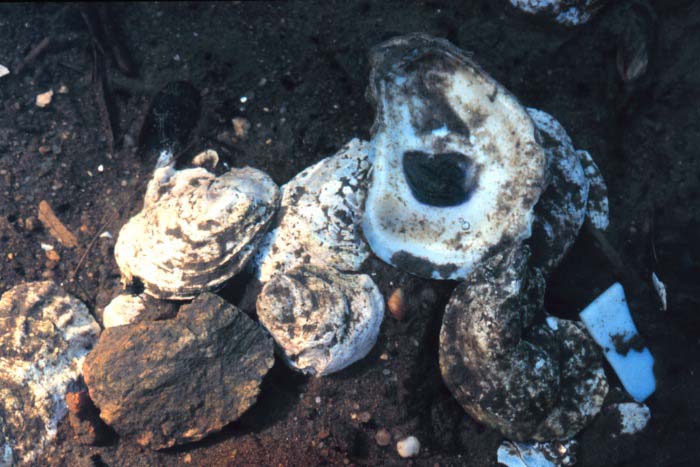
Courtesy of National Oceanic and Atmospheric Administration
Some animals are adapted to living in areas of high salinity; others can tolerate only low salt levels in the water. The Eastern oyster (Crassostrea virginica), for instance, can tolerate less than five parts per thousand salt, but its predator, the oyster drill, can stand no less than nine parts per thousand. The differences result in an oyster “line” that marks a safe zone for the mollusk.
Mixing of Freshwater and Saltwater
The mixing of freshwater and saltwater is driven by several factors, the most important of which are twice-a-day tides. Strong high tides, especially spring tides, push saltwater farther upstream, thereby raising an estuary’s overall salinity level. At low tide the rivers flowing into the estuary are no longer pushed back by the tides and thus may deliver more freshwater downstream, thereby decreasing salinity.
Storms at sea can push more seawater high into rivers and render them more saline. In addition, seasonal variations affect salinity levels. Salinity goes up when rivers and streams flow at low levels during summer droughts. During 1999 and 2000 scientists recorded unusually high salinities in many Georgia estuaries as a result of an ongoing dry spell.
On the other hand, salinity declines during the rainy season, when rivers and streams bring more freshwater into the estuary. Researchers have found, for instance, that heavy rains can dramatically increase the Ogeechee River’s freshwater flow into Ossabaw Sound. As a result, the sound can have salinities as low as one part per thousand. In general, salinity levels in southeastern estuaries are at their lowest during March, the time of maximum freshwater runoff. Because saltwater is heavier than freshwater, the water at the bottom of an estuary is usually saltier than that at the top. Nevertheless, Georgia’s estuaries tend to be vertically well mixed in all cases except the Savannah, which is routinely stratified.
For crabs, marine fish, shrimp, and other shellfish that live at least part of their lives in estuaries and salt marshes, variations in salinity are of utmost significance. The organisms often use salinity levels, along with other environmental cues, as ecological clocks to time reproduction so that it coincides with the best environment for their young.
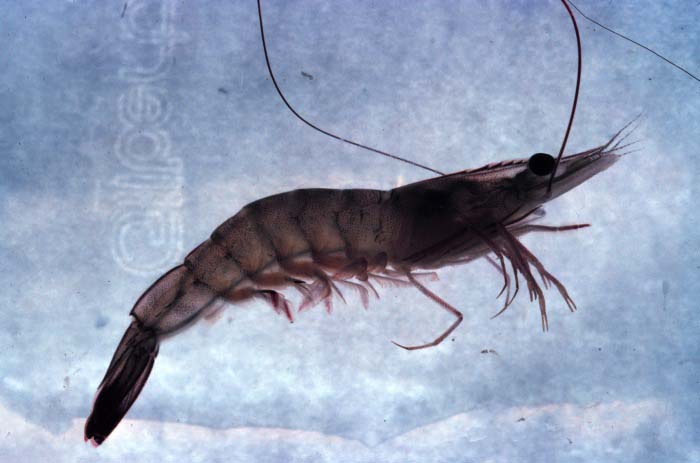
Courtesy of National Oceanic and Atmospheric Administration
As organisms mature, they develop the ability to adapt to the saltiness of the open sea. Like all creatures, though, they are most vulnerable and least tolerant of extreme environments when young. Thus, they spend most of their early lives in the gentle, brackish waters of estuaries and salt marshes. The brackish waters provide a perfect medium in which they can begin to develop a greater salt tolerance.
Countless numbers of young crabs, fish, shrimp, and other marine creatures, born in nearshore ocean spawning grounds, enter the estuaries as tiny larvae or as juveniles. The tides sweep the teeming masses into the creeks and marshes, where they are nourished and protected until early adulthood. Then, in late summer and fall, they depart the marsh nursery grounds, reenter the estuaries, and head back to the nearshore ocean waters to complete their life cycles.
An example of this cycle is that of the white shrimp (Litopenaeus setiferus), one of Georgia’s most commercially important marine species. A female shrimp spawns in ocean waters offshore, releasing about a million eggs. The fertilized eggs hatch into planktonic larvae, undergo several changes, and then enter the postlarval stage. At this time they enter the estuaries in currents generated by wind and tides and migrate upstream in the estuary. The young shrimp then move into tidal creeks, where they find ample supplies of food and protection from predators. The shrimp remain in their nursery habitats for two to three months. Upon reaching adulthood, they begin to move into larger creeks and rivers and move progressively down the estuary into more saline waters. From there, they migrate back to the sea for spawning.
Fauna
The inhabitants of estuaries can be categorized as plankton, which are minute plants and animals that freely drift in the water; benthic infauna, such as clams, sea worms, and some types of crustaceans and snails, which live in bottom sediments; epifauna, such as barnacles, which live on the surface of an object; and nekton, including fish, marine mammals, squid, and some crustaceans, which can swim through the water against currents. Some of these organisms are deposit feeders, like shrimp; some are suspension feeders, like oysters; and some are carnivores, like the blue crab, which may be both scavenger and predator.
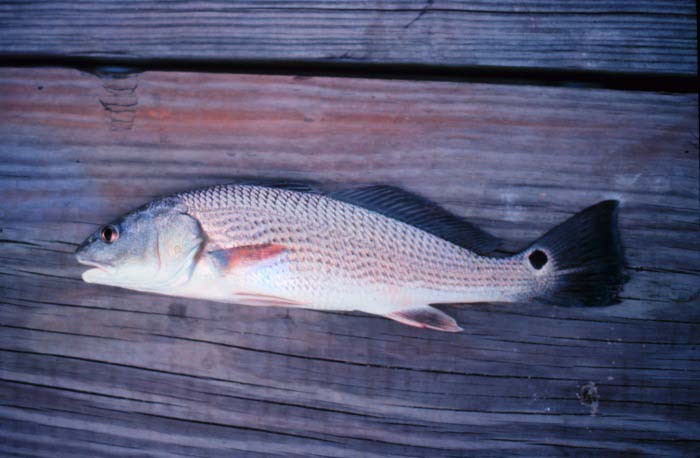
Courtesy of National Oceanic and Atmospheric Administration
Common finfish in Georgia’s estuaries include black drum, croaker, flounder, red drum, sheepshead, spotted sea trout, striped mullet, and whiting. The red drum (Sciaenops ocellatus), a fish highly popular with recreational anglers, is generally found in estuaries during the summer. Occasionally, it will enter freshwater. Depending on salinity, temperature, and food availability, adult fish move in schools to the ocean during spring and fall. Juvenile fish generally remain in the estuaries even during the winter.
Environmental Concerns
Because the contents of five river watersheds flow into Georgia’s estuaries, pollution from as far away as Atlanta and Augusta, along with pollution from points in between, can end up in estuaries. Such contamination adversely affects the health and productivity of the coastal ecosystem. Upstream from the estuaries, dams and heavy withdrawals of water from rivers for municipal and industrial use can significantly reduce the amount of freshwater flowing into the estuaries. The result can be higher salinity levels in the estuaries, which jeopardize the life cycles of many estuarine organisms. Of special concern in Georgia are applications by various groups for new surface-water withdrawal permits in the Altamaha, Ogeechee, and Savannah rivers.
Since the 1980s the quality and productivity of Georgia’s estuaries and inner shelf have declined remarkably due to both natural environmental deterioration and adverse human activities. Commercial fishery stocks have dramatically decreased with an increase in the salinity levels and harmful algal populations in coastal rivers and estuaries. The rapid growth of Georgia’s coastal population, human removal of freshwater from rivers, and pollution from the land have had a pronounced influence on the estuarine and coastal ecosystems of Georgia.


